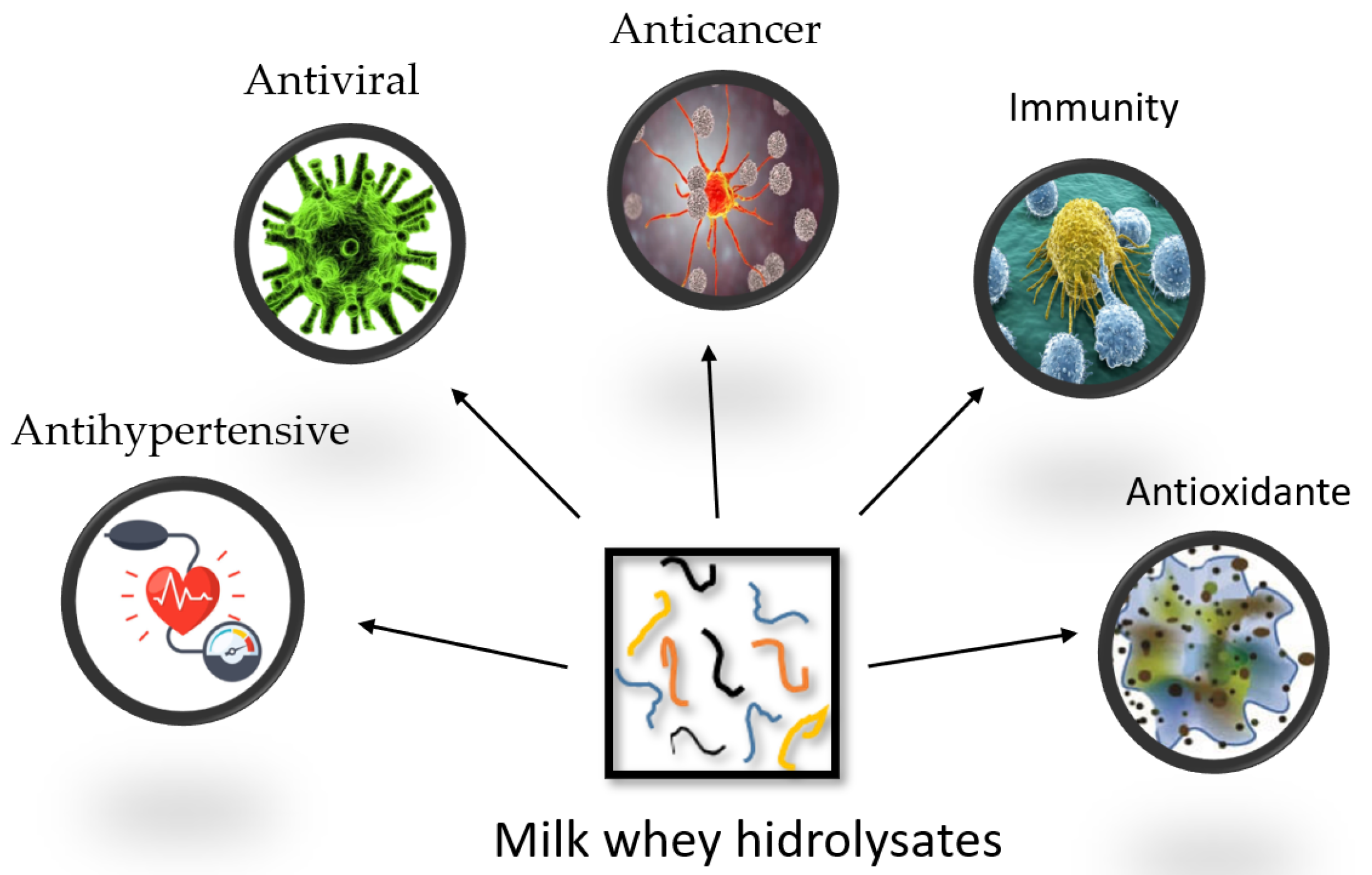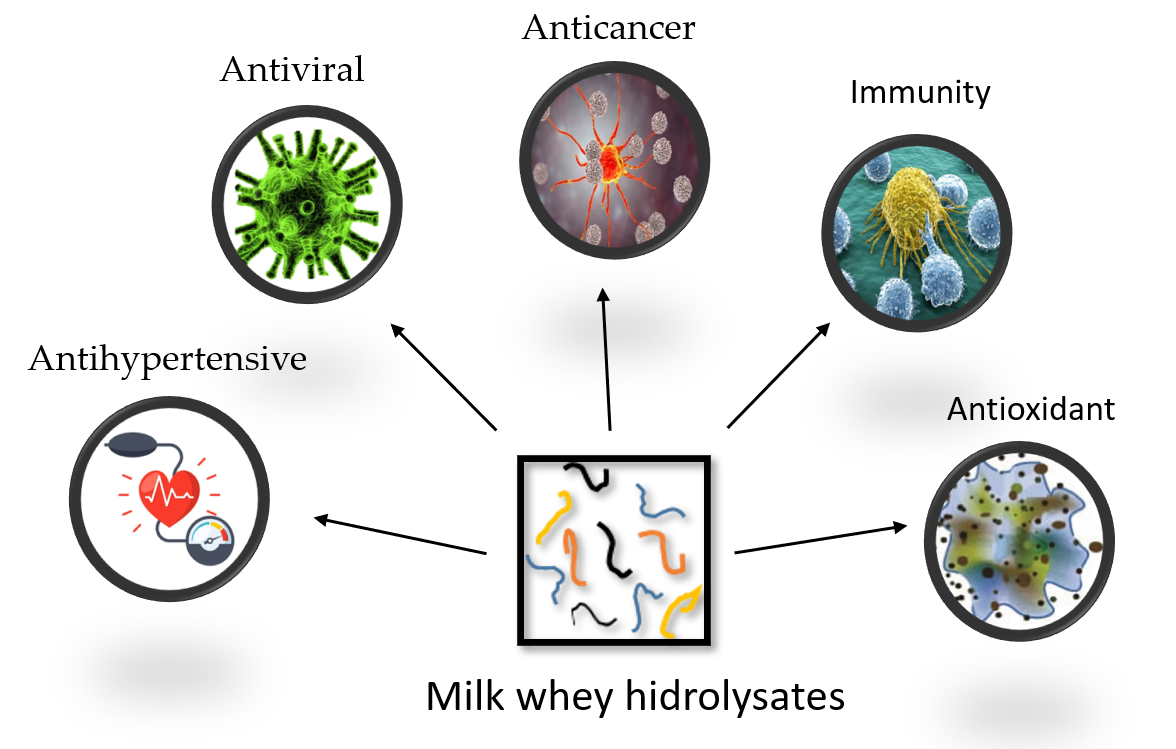There are two types of milk whey obtained from cheese manufacture: sweet and acid. It retains around 55% of the nutrients of the milk. Milk whey is considered as a waste, creating a critical pollution problem, because 9 L of whey are produced from every 10 L of milk. Some treatments such as hydrolysis by chemical, fermentation process, enzymatic action, and green technologies (ultrasound and thermal treatment) are successful in obtaining peptides from protein whey. Milk whey peptides possess excellent functional properties such as antihypertensive, antiviral, anticancer, immunity, and antioxidant, with benefits in the cardiovascular, digestive, endocrine, immune, and nervous system.
- milk whey
- hydrolysates
- immunity
- antiviral
- antihypertensive
1. Introduction
| Characteristics | Sweet Whey | Acid Whey |
|---|---|---|
| pH | >5.6 | <5.6 |
| Water | 93–94% | 94–95% |
| Protein (g/L) | 6–10 | 6–8 |
| Lactose (g/L) | 46–52 | 44–46 |
| Minerals (g/L) | 2.5–4.7 | 4.3–7.2 |
| Obtained by | Enzymatic action | Organic acids |
Whey is considered as a waste by-product from the production of cheese. The production of 1 kg of cheese generates approximately 9 kg of whey [7]. It is discarded without treatment to public sewage systems, creating a critical pollution problem. Unfortunately, only 50% of the whey produced globally is used to formulate products. Whey has been traditionally dumped into common water ducts or used to feed livestock. The treatment and re-use of whey is very important as it is one of the most polluting food by/co-product streams; its biochemical oxygen demand (BOD) is around 435,000 ppm and its chemical oxygen demand (COD) is 460,000 ppm [5][8][5,8]. Current environmental regulations are forcing cheese makers to treat whey before disposal. The continued growth of the cheese industry, the necessity for reduction in pollutants in the effluent, and the need to maximize returns on raw material have encouraged producers and researchers to seek new ways of using cheese whey with a great amount of research focused on converting this liability into an asset [7][8][9][10][11][7,8,9,10,11]. The protein content of whey is one of the main advantages of this by-product. It is known that diet is one of the factors that influence human health and the development of diseases. Proteins are important nutrients in foods that can be hydrolyzed into a wide range of peptides during gastrointestinal digestion. Some of these peptides share characteristics that act in the organism as hormones, neurotransmitters, or regulatory peptides [12]. The importance of whey protein peptides is associated with their functional properties. Some studies have demonstrated the action of these peptides as inhibitors of angiotensin converting enzyme (ACE) on the regulation of blood pressure and enhancement of the immune system. These hydrolysates also help to increase dopamine, improving memory in patients from the geriatric area. In the food industry, whey protein peptides present antimicrobial, antioxidant activities, and also emulsifying properties. All functional properties of whey protein hydrolysates are related to their molecular weight. These properties are in a latent state during the formation of the protein structure complex and is only activated when that structure is broken or hydrolyzed by different methods such as enzymatic action, chemical hydrolysis, and through the application of emerging technologies such as ultrasound and heat treatments [13][14][15][16][13,14,15,16].
2. Hydrolyzed Protein from Milk Whey as High Value-Added Compounds
The valorization of a waste product can be defined as a process that transforms waste through physical, thermal, chemical, or biological methods in order to create products that can be incorporated as part of the circular economy into production chains. Whey valorization focuses mainly on the concentration and transformation of lactose, proteins, or any other nutrients into new value-added compounds [17][18][60,61]. Some value-added compounds from whey have been extracted from different biotechnological approaches such as enzymatic, microbial, thermal, galacto-oligosaccharide probiotics (GOS), lactose fatty acid esters, biocolorants, aroma compounds, and bacterial cellulose [19][62]. Galacto-oligosaccharides (GOS) are a well-known class of probiotics or substrates that are selectively utilized by host microorganisms, conferring a health benefit [20][63]. GOS have various benefits to human health including the selective stimulation of the beneficial intestinal bacteria growth, maintenance of the normal flora balance in the intestine, increased calcium absorption, and decreased serum cholesterol levels and cancer risks. The health-promoting effects of GOS include immunomodulation, lipid metabolism, mineral absorption, weight management, and obesity-related issues, among others [21][22][23][64,65,66]. Lactose fatty acid esters are odorless, non-toxic, and biodegradable compounds of high importance for the food, cosmetics, and pharmaceutical industries. Lactose fatty acid esters have been recognized for their superior properties as attractive substitutes of synthetic surfactants, excellent emulsifying and stability properties in food products. Additionally, they present antimicrobial activity against many foodborne pathogens as well as medicinal properties such as anticancer activity [24][25][26][67,68,69]. Carotenoids are one of the most important natural pigments and can usually be extracted from plants. However, cheese whey, or deproteinized cheese whey, has been used for the production of carotenoids by using various microorganisms (Blakeslea trispora, Mucor azygosporus, Rhodotorula rubra) for the fermentation of various carbon sources such as glucose, sucrose, and xylose. Carotenoids possess biological functions such as antioxidant activity, reduction in cardiovascular diseases, anti-diabetic, anti-cancer, and anti-inflammation activities. The interest in the carotenoids from whey focuses on the use of low-cost substrates to reduce the production costs [27][28][29][70,71,72]. Fermentation is also an alternative way for the production of natural aroma compounds from milk whey and involves the use of several yeast strains such as Metschnikowia pulcherrima, Bacillus licheniformis, Wickerhamomyces pijperi, and Saccharomyces cerevisiae [30][31][32][33][73,74,75,76]. Bacterial cellulose (BC) is a biopolymer with important physiochemical properties such as water holding capacity, hydrophilicity, high degree of polymerization, mechanical strength, crystallinity, and porosity. All these BC characteristics represent a wide range of potential applications starting from the food industry and biomedicine to electronics and cosmetics. Bacterial cellulose extracted from whey through enzymatic and acidic pre-treatments can be considered as a cheaper growth medium for BC production due to the low-cost of raw materials as well as its enhanced BC yields [34][77], reducing environmental pollution from dairy waste. BC has been used as an edible antimicrobial food coating increasing shelf life as well as a healthy food supplement for patients with gastrointestinal disorders, obesity, cardiovascular diseases, and diabetes. BC is considered as a multifunctional food ingredient because it can be used to improve the rheology of foods as a fat replacer ingredient for the production of both low-calorie and low cholesterol food products [35][36][78,79].3. Functional Properties of Hydrolyzed Milk Whey Proteins
Milk whey biological functions are mainly related to the cardiovascular, digestive, endocrine, immune, and nervous systems. However, many of the bioactive peptides are encrypted in native whey protein, so in order to liberate these peptides, it is necessary to apply hydrolysis methods that generate milk whey hydrolysates. In recent years, milk whey hydrolysates have been studied due to their potential as a functional ingredient capable of producing beneficial effects on health such as immunity, antioxidant, anticancer, antiviral, and antihypertensive (Figure 12). At the same time, production of hydrolysates can be an interesting approach in adding value to whey protein, while at the same time protecting the environment from their pollutant effects [37][38][39][40][82,83,93,111].

4. Applications of Milk Whey Proteins Hydrolysates
| Product | Functionality | Reference | |
|---|---|---|---|
| Flavored milk beverage | Antioxidant activity | [46] | [154] |
| Whey MWH food supplementation in post-menopausal women | Increase muscle mass and strength | [58] | [165] |
| Apple juice | Low sedimentation | [49] | [156] |
| Beverage enriched white flaxseed oil | Increased of flavor, odor | [50] | [157] |
| MWH food supplementation in college-aged males | Increase mixed muscle and protein synthesis | [56] | [163] |
| MWH food supplementation | Improved recovery of muscle function and flexibility | [59] | [166] |
| Whey-raspberry flavored beverage | Antioxidant capacity and ACE inhibition | [48] | [148] |
| MWH food supplementation in athletes | Excellent source of nutritious | [55] | [162] |
| Whey protein-based beverage | Antioxidant and antimicrobial activity, no affecting physicochemical properties | [47] | [155] |
| Protein supplementation | Increasing mixed muscle and protein synthesis and lean body mass | [57] | [164] |
